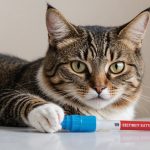Essential Guide to Syringe-Feeding Your Ill Cat: Effective Techniques for Nourishing a Picky Eater
Understanding the Need for Syringe Feeding
When your cat is ill, injured, or recovering from surgery, their appetite can significantly diminish, making it crucial to ensure they receive the necessary nutrients for recovery. Syringe feeding is a method that can be lifesaving in such situations, but it requires careful consideration and the right techniques to avoid stressing both you and your pet.
“Cats with poor appetite are sick, and if you wait until the appetite is completely gone, it may be too late for recovery,” notes the Mar Vista Animal Medical Center. This is particularly true for cats, as their liver is not designed to handle large amounts of fat mobilized to meet energy demands, which can lead to hepatic lipidosis.
Topic to read : What are the psychological effects of declawing on cats, and are there alternatives?
Choosing the Right Food
Before you start syringe feeding, it’s essential to select the right food for your cat. Here are some key considerations:
Nutritional Requirements
Your cat needs a diet rich in digestible protein, fat, and essential nutrients. Foods like Hill’s Prescription Diet a/d are clinically proven to support recovery with high levels of digestible protein and fat, and they have a smooth, soft consistency that makes them easy to syringe feed.
This might interest you : Recognizing Cognitive Decline in Senior Cats: How to Foster a Nurturing Environment for Them
Palatability
Cats often find canned diets more palatable than dry foods. “Most animals find canned diets far more palatable than dry foods,” explains the Mar Vista Animal Medical Center. This can make the feeding process less stressful and more effective.
Consult Your Veterinarian
Always consult with your veterinarian to determine the best food for your cat’s specific health condition. They can recommend the most suitable diet and provide guidance on how to transition your cat to this new food.
Preparing for Syringe Feeding
Equipment Needed
- Syringes (preferably with a soft tip to reduce discomfort)
- A comfortable and quiet feeding area
- Paper towels or a cloth bib for mess control
- The recommended cat food
Steps to Follow
Here is a detailed list of steps to help you prepare and execute syringe feeding effectively:
- Select a Quiet and Comfortable Area: Find a quiet, stress-free area where your cat feels comfortable. This will help reduce anxiety during the feeding process.
- Prepare the Food: If using canned food, you can stir it to make it more liquid-like, which is easier to syringe feed. For example, Hill’s Prescription Diet a/d can be stirred to achieve a more liquid consistency.
- Load the Syringe: Fill the syringe with the prepared food, making sure to remove any air bubbles to avoid discomfort or aspiration.
- Feed Gradually: Start by feeding small amounts to see how your cat reacts. Gradually increase the amount as needed.
- Monitor and Adjust: Keep an eye on your cat’s weight and overall health. Adjust the feeding schedule and amount based on your veterinarian’s advice.
Techniques for Syringe Feeding
Syringe Feeding Method
This method involves directly feeding your cat through a syringe. Here are some tips:
- Hold Your Cat Correctly: Hold your cat securely but gently, ensuring they are comfortable and not stressed.
- Insert the Syringe: Carefully insert the syringe into the corner of your cat’s mouth, aiming for the back of the throat.
- Feed Slowly: Feed slowly to avoid choking and to give your cat time to swallow.
- Clean Up: Use paper towels or a cloth bib to clean up any mess.
Meatball Method
For more cooperative cats, the meatball method can be an alternative:
- Make Small Meatballs: Form the food into small meatballs.
- Feed the Meatballs: Place the meatballs in the back of your cat’s mouth, similar to giving a pill.
- Ensure Complete Consumption: Make sure your cat has finished one meatball before offering another.
Comparing Syringe Feeding with Other Methods
Here is a comparative table to help you understand the pros and cons of different feeding methods:
| Feeding Method | Pros | Cons |
|---|---|---|
| Syringe Feeding | Direct delivery of nutrients, can be less stressful if done correctly | Can be messy, requires careful technique to avoid aspiration |
| Meatball Method | Less risk of aspiration, more natural texture | Can be stressful for the cat, potential for food aversion |
| Tube Feeding | Comfortable for the pet, allows for blenderized diets | Requires brief surgical placement, anesthetic risks apply |
| Canned Food | Highly palatable, easy to transition | May not be suitable for long-term feeding without veterinary advice |
Managing Common Challenges
Food Aversion
One of the significant challenges is food aversion, where the cat develops a negative association with the feeding process. To avoid this:
- Make Feeding Positive: Ensure the feeding process is as stress-free as possible.
- Use High-Palatability Foods: Choose foods that your cat finds highly palatable.
- Gradual Transition: Transition your cat to the new food gradually to avoid sudden changes.
Weight Monitoring
Monitoring your cat’s weight is crucial during the recovery period. Here’s how you can do it:
- Regular Weighing: Weigh your cat regularly to ensure they are not losing weight.
- Adjust Feeding Amounts: Adjust the feeding amounts based on your veterinarian’s advice and your cat’s weight changes.
Additional Care and Considerations
Fluid Therapy
In some cases, your cat may also require fluid therapy to stay hydrated. Here are some key points to consider:
- Subcutaneous Fluids: For cats with chronic kidney disease or other conditions, subcutaneous fluids can be administered at home. This involves inserting a needle between the shoulder blades and administering the prescribed amount of fluids.
- Monitoring: Keep a close eye on your cat’s response to fluid therapy and adjust as necessary based on your veterinarian’s guidance.
Veterinary Monitoring
Regular monitoring by your veterinarian is essential to ensure your cat is recovering well. Here’s what you should do:
- Follow-Up Appointments: Schedule regular follow-up appointments with your veterinarian to monitor your cat’s health.
- Report Changes: Report any changes in your cat’s appetite, weight, or overall health to your veterinarian.
Syringe feeding your ill cat can be a challenging but necessary task to ensure they receive the nutrients they need for recovery. By choosing the right food, preparing carefully, and using the correct techniques, you can make this process less stressful for both you and your cat.
“Nutrients must be delivered ideally in a way that is not stressful for either the pet or the human caretaker,” advises the Mar Vista Animal Medical Center. With patience, the right guidance, and the support of your veterinarian, you can help your cat recover and regain their health.
Remember, every cat is different, so it’s crucial to tailor your approach based on your cat’s specific needs and your veterinarian’s advice. By doing so, you can provide the best care possible and help your cat eat, recover, and thrive.











